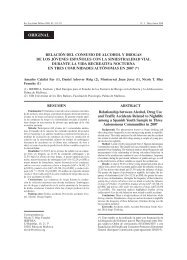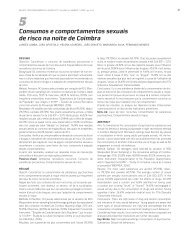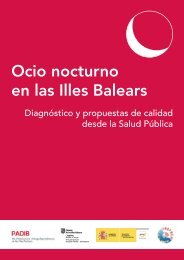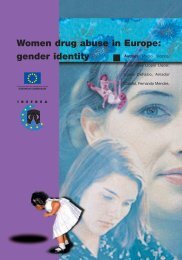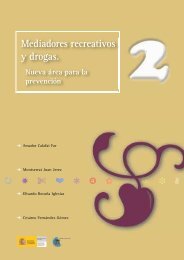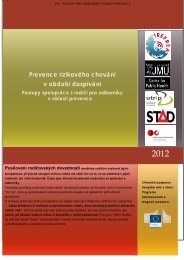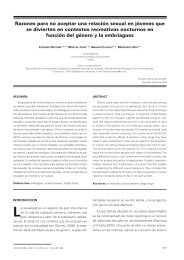follows; 60 % hash/marihuana, 11% <strong>ecstasy</strong>, 13% coca<strong>in</strong>e, 7% LSD, 8% amphetam<strong>in</strong>es,4% hero<strong>in</strong> taken nasally, <strong>and</strong> 1% dissolvents/glues.The results <strong>of</strong> the survey showed the follow<strong>in</strong>g; the importance that the respondentsattributed to feel<strong>in</strong>g “high” was, on the whole, rather limited. It was, however,significantly higher for users <strong>of</strong> more drugs <strong>and</strong> for s<strong>of</strong>t drug users <strong>in</strong> comparison withalcohol/tobacco users <strong>and</strong> non-users. The “high” experience seems significantly morefrequent as <strong>in</strong>volvement <strong>in</strong> substance use <strong>in</strong>creased. The frequency with which theyoung people <strong>in</strong> the survey visit discos was rather low (once a month). The scoresobta<strong>in</strong>ed on the Sensation Seek<strong>in</strong>g Scales <strong>in</strong>creased <strong>in</strong> a significant way <strong>in</strong> respect <strong>of</strong>the degree <strong>of</strong> familiarity with drugs <strong>in</strong> accordance with the level <strong>of</strong> importanceattributed to the “high” <strong>and</strong> the frequency <strong>of</strong> “be<strong>in</strong>g high”. The subscales whichobta<strong>in</strong>ed the highest scores were those relat<strong>in</strong>g to the “search for adventure <strong>and</strong>excitement”, <strong>and</strong> the “search for experiences”. The level <strong>of</strong> importance attributed to the“high” <strong>and</strong> the frequency <strong>of</strong> the “high” <strong>of</strong> the respondents related positively to three <strong>of</strong>the four subscales (DIS, BS, TAS). The degree <strong>of</strong> <strong>in</strong>volvement <strong>in</strong> use was positivelyrelated to the TAS Subscale <strong>and</strong> to the total items on the overall scale (SSES).On the bases <strong>of</strong> two <strong>in</strong>dependent op<strong>in</strong>ions, the 914 choices given as answers <strong>in</strong>respect <strong>of</strong> the word “high” were classified <strong>in</strong> 23 categories referr<strong>in</strong>g to four spheres;abstract (philosophical concepts, proverbs <strong>and</strong> metaphors); situational (risks, action,ambient, substance use, life style); relational (<strong>in</strong>teraction with friends; with partner);emotional (enjoy<strong>in</strong>g oneself, feel<strong>in</strong>g excited, changed, dis<strong>in</strong>hibited, experienc<strong>in</strong>g<strong>in</strong>tense feel<strong>in</strong>gs, <strong>of</strong> well-be<strong>in</strong>g, <strong>of</strong> malaise, a broaden<strong>in</strong>g <strong>of</strong> mental faculties). Theresults showed that the “be<strong>in</strong>g high” <strong>representation</strong>s centred most <strong>of</strong> all on theemotional (41,4%) <strong>and</strong> on the situational (35,9%). As for those relative to the contents,those <strong>in</strong> the emotional sphere focussed ma<strong>in</strong>ly on the choices relat<strong>in</strong>g to enterta<strong>in</strong>ment(f=104) <strong>and</strong> to the sensations <strong>of</strong> change/rapture (f=51) <strong>and</strong> to those onwellbe<strong>in</strong>g/relaxation (f=41). As for the situational sphere, the responses gave all theaspects relative to the ambient/ context/ <strong>of</strong> the “high” (f=80), on the use <strong>of</strong> substances(f=68) <strong>and</strong> to movement/action (f=42). References to “be<strong>in</strong>g high” centred on therelational dimension concerned with <strong>in</strong>teraction with friends <strong>and</strong> be<strong>in</strong>g <strong>in</strong> company(f=49) <strong>and</strong> affectionate/sexual relationships (f=44). Among the abstract <strong>representation</strong>s,metaphorically negative (f=27) <strong>and</strong> positive (f=21) choices prevailed.The variation analyses show that the situational choices were selected mostly byrespondents who said they had never experienced “be<strong>in</strong>g high”, whereas those whosechoices referred to emotional states were older.Analysis <strong>of</strong> the correlation between the four <strong>representation</strong>al spheres <strong>of</strong> the “high”show that the more the choices <strong>of</strong> emotional states, the less the choices <strong>of</strong> situationalaspects <strong>and</strong> <strong>in</strong>teraction. As age <strong>in</strong>creases so do the emotional choices. The correlationbetween the 4 <strong>representation</strong>al spheres <strong>of</strong> the “high” <strong>and</strong> the frequency <strong>of</strong> go<strong>in</strong>g to adisco, showed that the more frequent the visits to discos, the less the “high” wasconceptualised <strong>in</strong> abstract terms <strong>and</strong> the greater the importance given to it; the greaterthe tendency to dis<strong>in</strong>hibition <strong>and</strong> the search for strong emotion, the younger they were.146
The correlation between <strong>representation</strong>al dimensions <strong>of</strong> the high <strong>and</strong> SSESsubscales show that the dis<strong>in</strong>hibition scale is positively related to the situational choices<strong>of</strong> the “high” <strong>and</strong> negatively <strong>in</strong> respect <strong>of</strong> the choices <strong>of</strong> emotional states.The choices expressed <strong>in</strong> the two free association tests (f=1429) were classified <strong>in</strong>the first test <strong>in</strong> 53 response categories, <strong>in</strong> the second <strong>in</strong> 45, referr<strong>in</strong>g, <strong>in</strong> both cases, to4 spheres; private (sociological, relative to the body, lik<strong>in</strong>gs/hobbies,existential/emotional, personal qualities), public (roles/status <strong>and</strong> relationships), present<strong>and</strong> past. The results showed that choices <strong>in</strong> the private sphere clearly prevailed overthose <strong>in</strong> the public sphere (87,2% <strong>in</strong> the first test; 93,5% <strong>in</strong> the second). Whereas <strong>in</strong> thefirst test, the choice on the status <strong>of</strong> the student <strong>and</strong> worker prevailed, <strong>in</strong> the second, thechoice relat<strong>in</strong>g to the status <strong>of</strong> the user was particularly important. As for the contents,the descriptions <strong>in</strong> terms <strong>of</strong> personal qualities prevailed <strong>in</strong> both cases. It is verynoticeable that negative existential choices are more frequent among non-users.The result <strong>of</strong> this <strong>in</strong>terest<strong>in</strong>g survey show that “be<strong>in</strong>g high” is not sought, as themajority ma<strong>in</strong>ta<strong>in</strong>, to facilitate relationships with others but to experience differentemotional states. The subjects -<strong>representation</strong> <strong>of</strong> self-hav<strong>in</strong>g used substances” centreson more dysfunctional aspects.A subsequent survey was made by the same authors (Ravenna, Palmonari, 1996)with the objective <strong>of</strong> show<strong>in</strong>g the eventual relationship between frequent<strong>in</strong>g aparticularly stimulat<strong>in</strong>g <strong>social</strong> ambient, like a disco, <strong>and</strong> drug use. The survey wascarried out by self-observation studies <strong>of</strong> different moments <strong>in</strong> a s<strong>in</strong>gle night <strong>in</strong> a discoby a specifically tra<strong>in</strong>ed group <strong>of</strong> observers (young workers, apprentices, universitystudents, etc.). In a first phase, it concerned reconstruct<strong>in</strong>g the image, affectiveorientation <strong>and</strong> the knowledge <strong>and</strong> the degree <strong>of</strong> familiarity <strong>of</strong> the observers withdiscos. In a second phase, 20 observers (9 men <strong>and</strong> 11 women, aged between 22 <strong>and</strong>28) collected a series <strong>of</strong> self-observations <strong>in</strong> different discos us<strong>in</strong>g an expresslydesigned formula. This envisaged mak<strong>in</strong>g three reports at three different times dur<strong>in</strong>gthe night (15 m<strong>in</strong>utes after arrival, after two hours, <strong>and</strong> after leav<strong>in</strong>g). The follow<strong>in</strong>gaspects were <strong>in</strong>vestigated; sensations experienced, what was liked <strong>and</strong> disliked, quality<strong>of</strong> communication. The results showed that whereas 15 m<strong>in</strong>utes after enter<strong>in</strong>g the discopositive feel<strong>in</strong>gs prevailed over negative ones, after two hours <strong>of</strong> be<strong>in</strong>g there <strong>and</strong> afterleav<strong>in</strong>g, it was the opposite, the negative ones prevailed. What attracted the observersthe most were the aspects relat<strong>in</strong>g to the context which lasted dur<strong>in</strong>g the time. Thesewere followed by the relational <strong>and</strong> emotional aspects.A third survey analyses the <strong>representation</strong> <strong>of</strong> the disco with a sample <strong>of</strong> students(Ravenna, Palmonari, 1996). The questionnaire focused on the follow<strong>in</strong>g aspects:elements <strong>of</strong> attraction <strong>and</strong> repulsion with regard to the disco (us<strong>in</strong>g two open questions),orientation <strong>in</strong> respect <strong>of</strong> the search for strong sensations (us<strong>in</strong>g the reduced version <strong>of</strong>the SSES), degree <strong>of</strong> importance <strong>and</strong> frequency <strong>of</strong> experienc<strong>in</strong>g a “high”, frequency <strong>of</strong>go<strong>in</strong>g to discos. The questionnaire was given to 220 university students (53,2% men <strong>and</strong>46,8% women <strong>of</strong> an average age <strong>of</strong> 22 years) with vary<strong>in</strong>g degrees <strong>of</strong> familiarity withdrugs, 15% had never tried them, 23,2% were tobacco <strong>and</strong> alcohol users, 40,5% useds<strong>of</strong>t drugs <strong>and</strong> 21,3 also used hard drugs.147
- Page 3 and 4:
ORGANISATIONS AND NATIONAL RESEARCH
- Page 5 and 6:
This volume is dedicated very speci
- Page 7 and 8:
PRESENTATIONIt’s a great pleasure
- Page 9 and 10:
INDEXPág.1. INTRODUCTION . . . . .
- Page 11 and 12:
1. INTRODUCTION1.1. DESIGNER DRUGS,
- Page 13:
the most widely used because its ef
- Page 16 and 17:
All this led to the famous English
- Page 18 and 19:
had used it in the preceding month.
- Page 20 and 21:
had used ecstasy or a similar subst
- Page 22 and 23:
school population found a prevalenc
- Page 24 and 25:
isk factors among adolescents (Cala
- Page 26 and 27:
make quantitative what is qualitati
- Page 28 and 29:
concentrated in ecstasy use. A stud
- Page 30 and 31:
the others versions but with less i
- Page 33 and 34:
3. SAMPLE DESIGN AND FIELD WORK3.1.
- Page 35 and 36:
Two different methods were suggeste
- Page 37 and 38:
according to drug use level. Finall
- Page 39 and 40:
We came into contact with eight ind
- Page 41 and 42:
4. SOCIODEMOGRAPHIC BACKGROUNDINTRO
- Page 43 and 44:
We did not think it would be necess
- Page 45 and 46:
STUDY LEVEL (% on global sample; %
- Page 47 and 48:
In Utrecht, most of the young peopl
- Page 49:
SUMMARYWe remind again that, in spi
- Page 52 and 53:
This classification will be used fr
- Page 54 and 55:
Montagne, 1992) or Rimini, in Italy
- Page 56 and 57:
RELIGION PRACTITIONER (% on global
- Page 58 and 59:
It stands out the high percentage o
- Page 60 and 61:
Amphetamines are often used with fr
- Page 62 and 63:
In the Utrecht sample, however, alt
- Page 64 and 65:
GLOBAL SAMPLE ANSWERSThe most popul
- Page 66 and 67:
These data are interesting in order
- Page 68 and 69:
WITH WHOM TO CONSUME ECSTASY? (In %
- Page 70 and 71:
As we have already seen in other ta
- Page 73 and 74:
6. SENSATION SEEKING SCALE (SSS)6.1
- Page 75 and 76:
correlation’s varies in function
- Page 77 and 78:
consumers sample comprises individu
- Page 79 and 80:
DISINHIBITION (DIS)Modena, Palma an
- Page 81 and 82:
y the non-consumer groups. In addit
- Page 83 and 84:
Once again, on the Boredom Suscepti
- Page 85:
this new scale. The individuals bel
- Page 88 and 89:
Still following psychoanalysis, Koh
- Page 90 and 91:
seeking scale, the hypotheses for t
- Page 92 and 93:
SDS results according to sexSexPunc
- Page 94 and 95: understanding and explaining realit
- Page 96 and 97: there would be two more or less dif
- Page 98 and 99: RELATION BETWEEN ECSTASY AND SEXThe
- Page 100 and 101: of medicaments. In fact, they are p
- Page 102 and 103: In any case, it is true indeed that
- Page 104 and 105: Well aware that these interpretatio
- Page 106 and 107: with others, facilitates being able
- Page 108 and 109: 8.3.2. Social Representation in the
- Page 110 and 111: with problems”, “the problem wi
- Page 112 and 113: feel good”, “it causes euphoria
- Page 114 and 115: Therefore, and taking into account
- Page 116 and 117: appear in the diagram, as they have
- Page 118 and 119: as one of the reasons for taking ec
- Page 120 and 121: In the C diagram we see distributio
- Page 122 and 123: shy people” and “escape from re
- Page 124 and 125: We believe the adequate way of inte
- Page 126 and 127: In the C group there are five compo
- Page 128 and 129: ecause ecstasy use is connected wit
- Page 130 and 131: Nowadays, three studies are being c
- Page 132 and 133: can become addictive conducts and h
- Page 134 and 135: therapeutic virtues that have been
- Page 136 and 137: CESDIP/CNRS, Centre d’Etudes et d
- Page 138 and 139: The Interior Ministry considers tha
- Page 140 and 141: In spite of the methodological limi
- Page 142 and 143: directed at investigating the quali
- Page 146 and 147: The results highlighted that respon
- Page 148 and 149: young people interviewed considered
- Page 150 and 151: In the last few years, however, in
- Page 152 and 153: 04) Ensuring that water is availabl
- Page 154 and 155: ♦ Zini G., Indagine sul consumo d
- Page 156 and 157: Ossebaard, H.C. (1996). Drugspreven
- Page 158 and 159: From the secondary school populatio
- Page 160 and 161: Huizer, H. (1996). Rapport over het
- Page 162 and 163: A related theme is to describe toda
- Page 164 and 165: Verhulst, J. (1996). XTC kan altijd
- Page 166 and 167: Because this review is meant to giv
- Page 168 and 169: 170Mudde, L. (1997). ‘XTC is nog
- Page 170 and 171: 2) The second research was carried
- Page 172 and 173: Even so it is possible to make a di
- Page 174 and 175: At the round table of social Analys
- Page 176 and 177: 2. Press articles regarding ecstasy
- Page 178 and 179: Comas Arnau D, Velázquez Andrés J
- Page 180 and 181: 182estimulantes. p. 111-29.Salazar
- Page 182 and 183: to the middle and upper classes. Th
- Page 184 and 185: The culturally sensitive poly-consu
- Page 186 and 187: SOCIAL REPRESENTATIONS OF CONSUMERS
- Page 188 and 189: stereotype, there was also the mess
- Page 190 and 191: their habitual environment, without
- Page 192 and 193: experiment with drugs such as heroi
- Page 194 and 195:
This policy is being received very
- Page 196 and 197:
SPECIFIC EUROPEAN PREVENTIVE CAMPAI
- Page 198 and 199:
The material used was a triptych, c
- Page 200 and 201:
establishments. This first initiati
- Page 202 and 203:
The latest campaign which formed pa
- Page 204 and 205:
NETHERLANDSIn Holland, there have b
- Page 206 and 207:
Don’t force yourself to be always
- Page 208 and 209:
preventive strategies related to ec
- Page 210 and 211:
Within the harm minimisation strate
- Page 213 and 214:
11. PREVENTION PROPOSALSPREVENTION
- Page 215 and 216:
implied danger), but depending on w
- Page 217 and 218:
Despite the different policies on d
- Page 219 and 220:
12. GENERAL BIBLIOGRAPHY001. Abric,
- Page 221 and 222:
031. Díaz, A., Barruti, M. and Don
- Page 223 and 224:
misuse. Addiction 89.068. Kandel, D
- Page 225 and 226:
102. O’Rourke, P.J. (1985) Tune i
- Page 227:
137. Ureña, M.M. and Serra, F. (19
- Page 230 and 231:
The interview will be semi-structur
- Page 232 and 233:
♦ which subjects are the most fre
- Page 235 and 236:
ANNEX 3QUESTIONNAIRE OF SOCIALREPRE
- Page 237 and 238:
06. Birthplace (city and country):-
- Page 239 and 240:
19. In the last three months, how m
- Page 241 and 242:
30. Have you taken any other substa
- Page 243 and 244:
Next sentences are about your prefe
- Page 245 and 246:
SOCIAL REPRESENTATIONSINSTRUCTIONSB
- Page 247 and 248:
ANNEX 4PROTOCOL TO RECRUIT THE DISC
- Page 249 and 250:
⇒ envelopes with stamp and addres
- Page 251:
I R E F R E AIREFREA is a european



